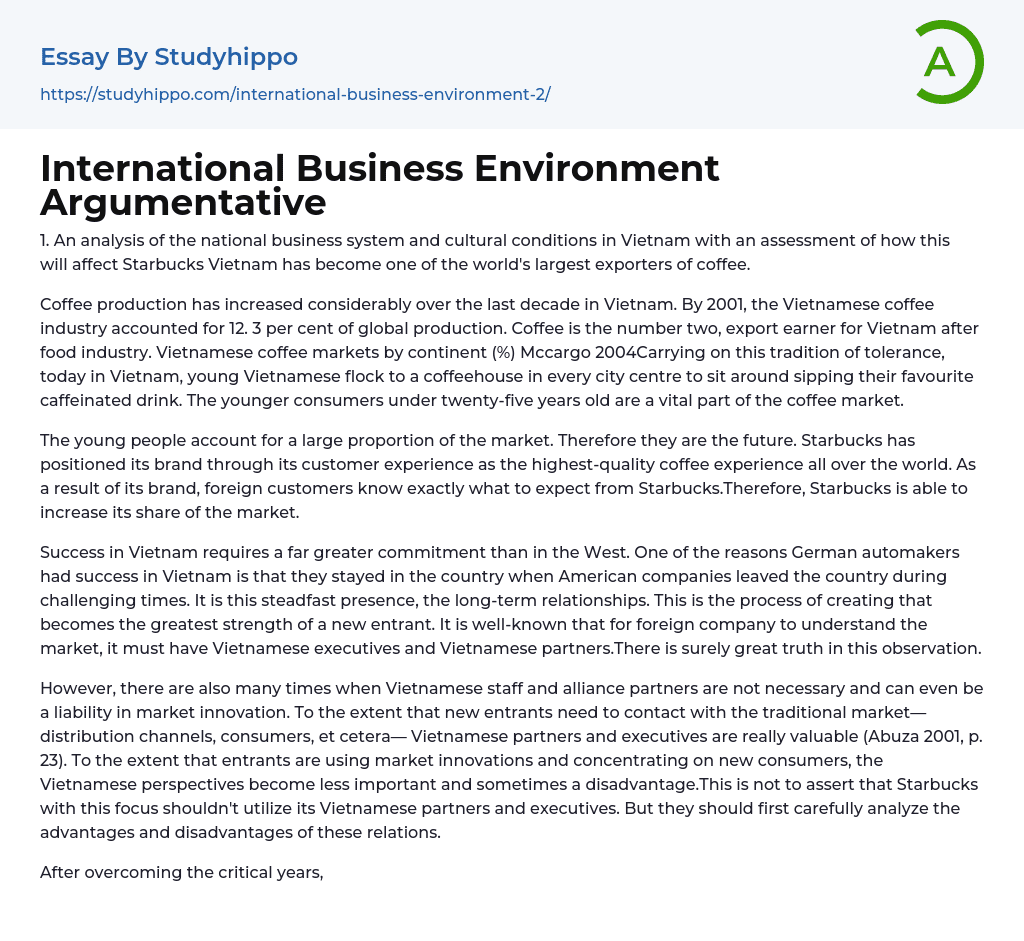

International Business Environment Argumentative Essay Example
Examining the national business system and cultural climate in Vietnam is crucial in evaluating the impact on Starbucks as Vietnam is a major global coffee exporter.
The coffee industry in Vietnam has seen significant growth in the past decade, resulting in it accounting for 12.3% of global coffee production by 2001. After the food industry, coffee is the second highest export earner for Vietnam. Mccargo's 2004 study reports the percentage of Vietnamese coffee markets by continent. This tradition of coffee consumption has continued, with modern-day Vietnamese youth frequenting coffeehouses in every city center to enjoy their favorite caffeinated beverage. The under twenty-five demographic is crucial to the Vietnamese coffee market's success.
Due to their large proportion in the market, young people are considered the future. Starbucks has established itself as an elite coffee experience worldwide by prioritizing customer satisfaction.
...This has allowed the brand to increase its market share, as foreign customers know what to expect from Starbucks.
In Vietnam, achieving success demands a much higher level of dedication than in Western countries. German car manufacturers were able to thrive in Vietnam by remaining present in the country, even during difficult times when American companies left. This consistent presence allowed for the establishment of long-term relationships, which is a key component for new entrants. It is commonly recognized that foreign companies must have Vietnamese executives and partners to truly comprehend the market. This observation holds considerable merit.
Although Vietnamese staff and alliance partners can provide valuable assistance when it comes to contacting traditional markets such as distribution channels and consumers, there are also instances where their involvement can hinder market innovation. If new entrants are focused on targeting
new consumers and implementing market innovations, the perspectives of Vietnamese partners and executives may not be as relevant and could even be a disadvantage (Abuza 2001, p.23). However, this does not mean that Starbucks should completely disregard their Vietnamese partners and executives. Rather, they should carefully evaluate the pros and cons of these relationships before making any decisions.
Table 1 indicates that the Vietnamese economy is currently experiencing a period of strong growth following a challenging period. In 2004, the GDP growth rate was recorded at 7.25 percent while the macroeconomic environment reached a state of balance, as reported by VVG's Economic Indicators in 2007. Vietnamese businesses and the government alike have recognised and capitalised on the potential for trade and investment with Asia, as noted by Grossheim and Houben in their publication from 2001 (p. 69). Vietnam is establishing itself as a driving force for progress and development throughout the Asian region.
In 2007, Vietnam experienced a growth rate of 8.5% in their GDP primarily due to the industry and construction sector. Despite constraints in previous years, gross fixed investment increased by approximately 20% in 1993, as well as notable growth in both exports and imports.
Index Mundi 2007 highlights how Vietnam's development in market conditions and opportunities is in line with the rest of Asia (CIEM 2002). Vietnam has established a unique model of development, which contrasts with the gradual market development of European and American countries. Although some other Asian countries have progressed at a faster rate than Vietnam, none have made such significant advancements in development. Therefore, Vietnam's shift from a controlled local market to a thriving, refined, more consumer-oriented market
scheme has become a blueprint for other Asian nations to follow.
Starbucks faces various difficulties when trying to enter Vietnam. The Vietnamese might perceive this move as excessive globalization, distasteful and as an example of American cultural domination. This could certainly irritate Vietnamese nationalists. Leaders in Vietnam have communicated their stance that modernization does not equate to Westernization. Throughout Asia, there is a distinction between a push for a more modern society and the preservation of cultural and societal norms that differ greatly from those in the West.
The significance of Vietnam has risen due to its status as a prosperous, advanced society that deviates from Western norms (Abuza 1998, p. 1109).
- Beef essays
- Beer essays
- Beverages essays
- Bread essays
- Burger essays
- Cake essays
- Coconut essays
- Coffee essays
- Cooking essays
- Crowd essays
- Cuisines essays
- Dairy essays
- Desserts essays
- Dinner essays
- Drink essays
- Fast Food essays
- Favorite Food essays
- Food Safety essays
- Food Security essays
- Food Waste essays
- Fruit essays
- Ginger essays
- Hamburger essays
- Ice Cream essays
- Juice essays
- Lemon essays
- Meal essays
- Meat essays
- Oreo essays
- Organic Food essays
- Pizza essays
- Rice essays
- Sainsbury essays
- Sugar essays
- Taste essays
- Tea essays
- Wine essays
- American Dream essays
- Barriers To Entry essays
- Capitalism essays
- Central Bank essays
- Compensation essays
- Consumerism essays
- Economic Development essays
- Economic Growth essays
- Economic Inequality essays
- Economic System essays
- Economy essays
- Employment essays
- Export essays



